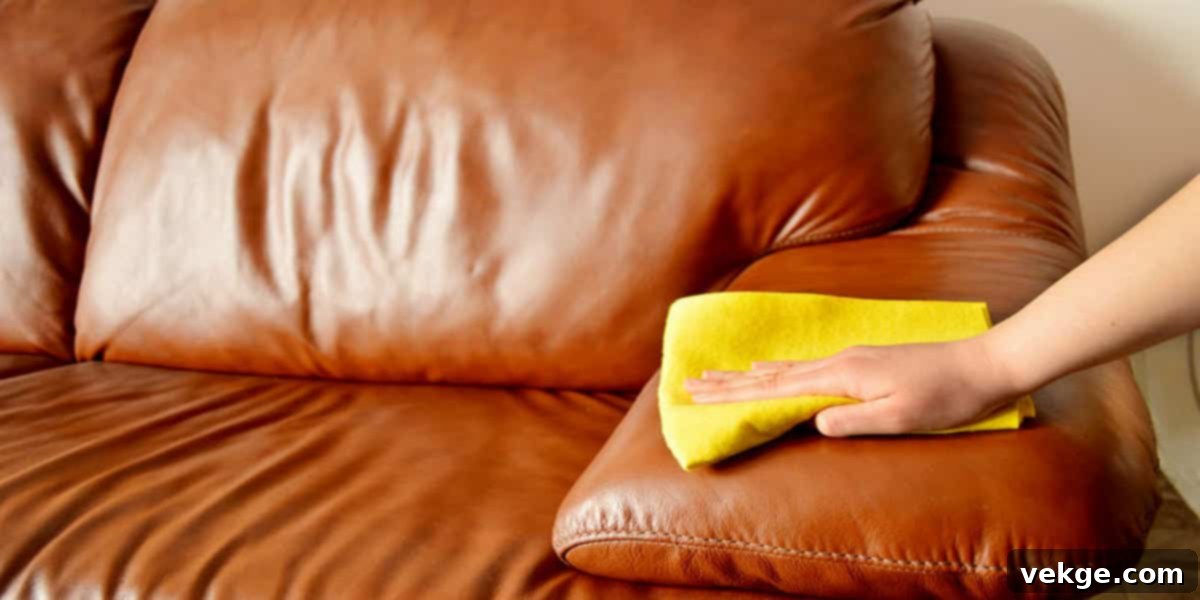The Ultimate Guide to Cleaning and Maintaining Your Farmhouse Leather Sectional
A farmhouse leather sectional is more than just a piece of furniture; it’s a significant investment that brings a unique blend of comfort, style, and rustic charm to your living space. Its inherent durability is indeed commendable, making it a beloved choice for many homes. However, even the most robust leather requires dedicated care to retain its luxurious feel and appearance over the years. Just like any other prized possession, consistent cleaning and maintenance are absolutely essential to ensure your leather sectional remains in pristine condition, looking as inviting as the day you brought it home.
While the thought of maintaining leather might seem daunting or time-consuming, it’s actually far simpler than you might imagine. With the right approach and a little consistency, caring for your leather sectional can be as straightforward as tending to your favorite houseplants. To truly preserve the elegance and comfort that your farmhouse leather sectional brings to your home, understanding and implementing proper care routines is paramount.
If you’re unsure where to begin or how to best care for this beautiful centerpiece, don’t worry – we’ve got you covered! This comprehensive guide will walk you through everything you need to know to keep your leather sectional looking its best for decades to come.
1. Understanding and Cleaning Your Farmhouse Leather Sectional
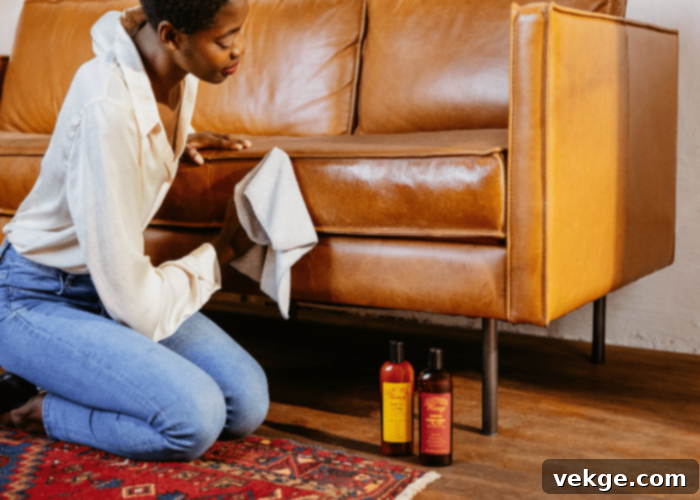
Before diving into any cleaning routine, it’s crucial to understand that not all leather is created equal. Different types of leather demand different cleaning approaches. The first and most important step in maintaining your leather sectional is to identify the specific type of leather your furniture is made from. This information is vital because using the wrong cleaning product or technique can cause irreversible damage.
Generally, leather used in furniture falls into a few main categories, but for practical cleaning purposes, we’ll focus on two primary types: Aniline (unprotected) and Protected leather. If you’re unsure about the leather type of your sectional, start by checking the manufacturer’s labels, care tags, or their official website. This information is usually readily available and will guide you toward the correct maintenance procedures.
Aniline Leather (Unprotected Leather) and Its Maintenance
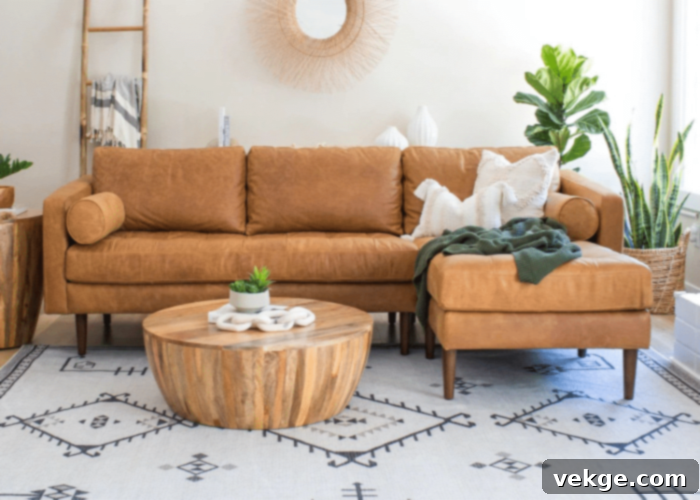
Aniline leather is celebrated for its incredibly natural look and soft, luxurious feel. You might encounter it under various names such as pure Aniline, full Aniline, or unfinished leather. What defines Aniline leather is that it’s dyed using a transparent aniline dye, which penetrates the hide without coating its surface with pigments. This process allows the natural grain, markings, and characteristics of the leather to remain visible, offering an authentic and unique aesthetic.
However, this natural beauty comes with a caveat: Aniline leather has no protective surface coating. This makes it highly susceptible to absorbing liquids and oils, leading to staining. Common variations include “pull-up” leather, where oils and waxes are integrated to create a distressed look that lightens when stretched, and “nubuck” leather, which is buffed on the grain side to produce a velvety soft texture. Both require gentle and specific care.
Cleaning Aniline Leather:
Given its delicate nature, the best source for cleaning directions is always the manufacturer’s specific guidelines. For routine maintenance, the simplest and safest way to clean this sensitive leather is by regularly dusting it with a soft, dry, and clean cloth. This helps prevent dust and debris from settling into the leather’s pores. Vacuuming can also be very effective for removing dust from crevices, but it’s crucial to use a soft brush attachment to avoid scratching or damaging the surface.
For a deeper clean or to gently remove light surface grime, a cloth dampened with distilled water can work wonders. Lightly wipe the surface, being careful not to over-saturate the leather. Distilled water is preferred because tap water can contain minerals that might leave marks or alter the leather’s appearance. Always follow up by gently patting dry with another clean, soft cloth. Before applying any new cleaning product, especially commercial ones, always test it on an inconspicuous area of the sectional – like the back or underneath a cushion – to ensure there are no adverse reactions. Consulting a professional leather care specialist for advice on specific stains or products is also a wise precaution.
Protected Leather and Its Maintenance
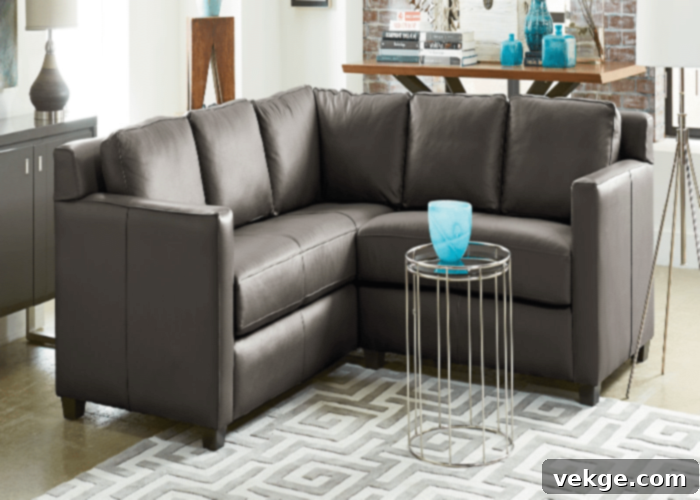
Protected leather, often found under labels like semi-aniline, pigmented, or aniline plus pigment leather, is the more common choice for modern leather furniture manufacturing due to its enhanced durability and ease of care. This type of leather features a protective topcoat of pigment and/or a clear finish, which makes it significantly more resistant to stains, fading, and general wear and tear compared to unprotected Aniline leather. This protective layer makes it ideal for high-traffic areas and homes with children or pets.
Cleaning Protected Leather:
Even with its protective coating, it’s always best to start any new cleaning procedure on an inconspicuous part of the sectional. This precautionary step helps ensure that the cleaning solution won’t damage or discolor the visible surfaces. A crucial rule for protected leather is to absolutely avoid cleaning products containing ammonia or harsh solvents, as these can strip the protective finish and cause irreparable damage. Always opt for cleaning products from reputable brands specifically formulated for protected leather.
To begin cleaning your protected leather sectional:
- Vacuum Regularly: Start by vacuuming the entire sectional using a soft brush attachment. This removes loose dust, crumbs, and debris that can scratch the surface if rubbed in during wet cleaning. Aim for weekly vacuuming, or more frequently in busy households.
- Prepare Cleaning Solution: Mix a small amount of mild, non-detergent liquid soap (like a gentle hand soap or dish soap without strong degreasers) with distilled water. The ratio should be about a teaspoon of soap to a quart of distilled water. This creates a gentle, effective cleaning solution.
- Wipe Down: Dampen a clean, soft microfiber cloth with the cleaning solution. Wring out excess liquid thoroughly; the cloth should be damp, not wet. Gently wipe the surface of the leather from top to bottom, working in small sections. Avoid scrubbing aggressively.
- Rinse: After cleaning a section, dampen a separate, clean microfiber cloth with only distilled water. Wipe the same area to remove any soap residue. Rinsing is important to prevent a sticky film from accumulating on the surface.
- Dry: Finally, use a clean, dry towel to gently buff the area dry. Ensure the leather is completely dry before using the sectional again.
Regular cleaning, ideally every 2-4 weeks for active households, will keep your protected leather looking fresh and extend its lifespan significantly.
2. Condition Your Farmhouse Leather Sectionals

Beyond routine cleaning, conditioning is a vital maintenance tactic that helps keep your leather sectional soft, supple, and resistant to cracking. Leather, much like skin, can dry out over time, especially when exposed to direct sunlight or dry indoor air. A good quality leather conditioner replenishes the natural oils that keep the leather hydrated and flexible, preventing it from becoming brittle and developing unsightly cracks.
Before selecting a conditioner, always consult your sectional’s care labels or the manufacturer’s website for specific recommendations. Not all conditioners are suitable for all leather types; using the wrong one can do more harm than good, especially for Aniline leather. Always choose a commercial leather conditioner from a reputable brand, ensuring it’s compatible with your specific leather type. Perform a patch test on an inconspicuous area first.
How to Condition:
- Clean First: Always condition freshly cleaned leather. Any dirt or grime will be sealed in if you apply conditioner over it.
- Apply Sparingly: Apply a small amount of conditioner to a clean, soft cloth.
- Rub Gently: Rub the conditioner into the leather in small circular motions, ensuring even coverage. Don’t over-apply; a thin, even coat is all that’s needed.
- Allow to Absorb: Let the conditioner absorb into the leather for the time recommended by the product’s instructions (usually 10-15 minutes).
- Buff Off Excess: Use a separate clean, dry cloth to gently buff off any excess conditioner, leaving a soft, lustrous finish.
The frequency of conditioning depends on various factors, including the type of leather, its exposure to sunlight and heat, and how often it’s used. For most farmhouse leather sectionals, conditioning every 6-12 months is a good general guideline, or more often if the leather appears dry or stiff.
3. Cleaning Spills, Stains, & Spots
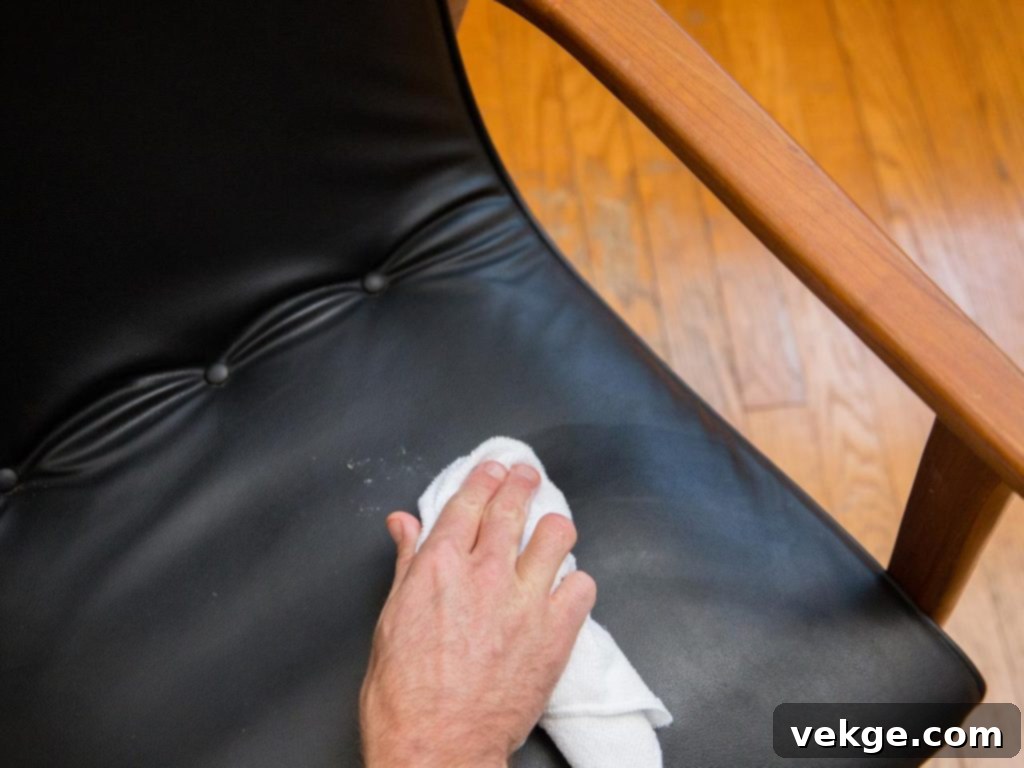
Leather’s sensitivity to spills is quite high, and liquid spills can be particularly challenging. The golden rule for any spillage on your leather sectional is to act immediately. The longer a spill sits, especially on unprotected leather, the more likely it is to be absorbed and set into a stubborn stain, potentially causing permanent damage or discoloration.
Handling Different Types of Spills and Stains:
- Water-Based Spills: For fresh liquid spills like water, juice, or soda, immediately blot the excess liquid with a clean, dry, absorbent cloth. Do not rub, as this can spread the stain and push it deeper into the leather fibers. After blotting, gently wipe the area with a cloth slightly dampened with distilled water. Finish by blotting dry with another clean cloth. For protected leather, a very diluted solution of mild soap and distilled water can be used if the stain persists, followed by a rinse with plain distilled water and drying.
- Stubborn Stains (for Protected Leather): For more persistent, non-oily stains on protected leather, create a solution of mild, non-detergent soap with lukewarm distilled water. Dampen a microfiber cloth with this solution, wring it out well, and gently dab or blot the stain. Avoid aggressive scrubbing. Once the stain is lifted, use a cloth dampened with plain distilled water to remove any soap residue, and then dry the area with a clean, dry towel.
- Oil and Grease Stains: These are particularly tricky because leather is porous and can absorb oils quickly. For fresh oil or grease spills, immediately blot up as much excess as possible with a clean, dry cloth. Then, lightly sprinkle an absorbent powder like cornstarch or talcum powder directly over the stain. Let it sit for several hours, or even overnight, to absorb the oil. Gently brush off the powder. If a residue remains, a specialized leather degreaser from a reputable brand designed for your leather type might be necessary. Always follow product instructions carefully and test on an hidden area first. Never use water on oil stains, as it can set the grease.
- Ink Stains: Ink is one of the most difficult stains to remove. For fresh ink marks, some specialized leather ink removers or sticks are available. Act quickly. If the ink has dried, or for larger marks, it’s often best to consult a professional leather cleaning specialist to avoid accidentally spreading the ink or damaging the leather.
Remember, patience and gentleness are key when dealing with spills and stains. Always blot, never rub, and work from the outside of the stain inwards to prevent spreading.
Essential Tips for Caring & Maintenance of Your Farmhouse Leather Sectional
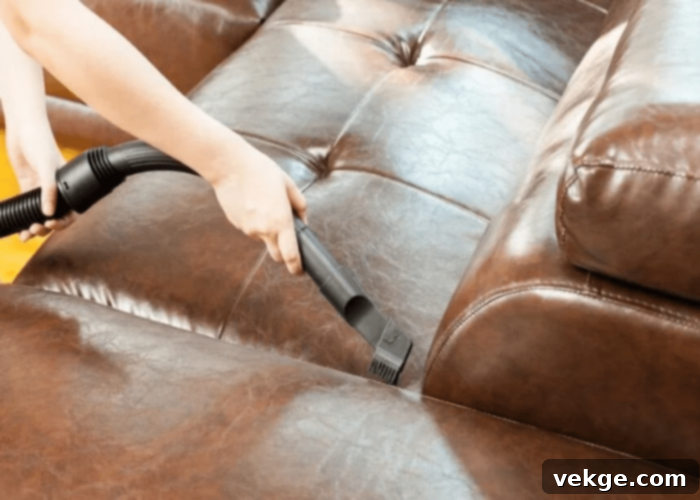
Beyond the specific cleaning and conditioning routines, here are some crucial tips to ensure the long-term beauty and durability of your farmhouse leather sectional:
- Avoid Home Remedies at All Costs: This is perhaps the most important piece of advice. Steer clear of internet-based “home potions” or remedies for cleaning leather, such as using olive oil, hairspray, nail polish remover, furniture polish, or abrasive cleaners. These substances are not formulated for leather and can cause irreversible damage like discoloration, drying, stickiness, or breakdown of the leather’s finish. Not only will you risk permanent harm to your expensive furniture, but using unapproved chemicals will almost certainly void your manufacturer’s warranty. Stick to products specifically designed and recommended for your type of leather.
- Strategic Placement: Position your leather sectional away from direct sunlight and heat sources like fireplaces, radiators, or heating vents. Prolonged exposure to UV rays can cause the leather to fade, dry out, and crack. Similarly, excessive heat can dry out the natural oils in the leather, leading to brittleness and damage over time. Maintain a comfortable room temperature and humidity level to preserve the leather’s integrity.
- Regular Dusting and Vacuuming: Implement a routine of gently wiping your sectional weekly with a dry, soft microfiber cloth to remove dust and loose debris. Every few weeks, use a vacuum cleaner with a soft brush attachment to get into seams and crevices, preventing dirt from building up and potentially scratching the surface.
- Protect from Sharp Objects: Be mindful of sharp objects like keys, pens, or even pet claws, which can easily scratch or puncture leather. If you have pets, consider using throws or blankets to protect frequently used areas, and keep their nails trimmed.
- Recommended Cleaning Materials: For effective and safe leather care, you don’t need a vast arsenal of products. Essential items include:
- Distilled Water: For diluting cleaners and rinsing, to avoid mineral deposits from tap water.
- Soft Microfiber Cloths: Essential for gentle cleaning, applying conditioner, and drying. Have several on hand.
- Vacuum Cleaner with Soft Brush Attachment: For removing loose debris without scratching.
- Mild, Non-Detergent Liquid Cleaner or Soap: Specifically for protected leather, or specialized leather cleaner.
- Leather Conditioner: An optional but highly recommended material for maintaining suppleness and preventing drying.
- Drop Cloth or Towels: To protect the floor during cleaning.
- Professional Cleaning: Consider hiring a professional leather cleaning service every 1-2 years, especially for stubborn stains or if your sectional sees heavy use. Professionals have the expertise and specialized tools to deep clean and restore leather safely.
Wrapping Up: Long-Lasting Beauty for Your Farmhouse Leather Sectional
Your farmhouse leather sectional is a cherished focal point in your home, embodying both comfort and rustic elegance. With the right methods of cleaning, conditioning, and caring for it, this beautiful piece of furniture can not only last for a very long time but also develop a rich, appealing patina that enhances its character over the years. Consistent and informed care is truly the secret to its longevity.
The basic routine for maintaining your leather furniture is straightforward: regularly wipe down the surfaces to remove dust and loose debris, and address spills immediately. Crucially, always use cleaning solutions and conditioners specifically meant for leather sectionals, and absolutely avoid experimental home tricks or tips you might read online, as these often lead to irreparable damage and voided warranties. For stain removal, the cleaning approach will depend heavily on the type of leather and the nature of the stain itself, emphasizing the importance of identifying your leather type first.
By following these guidelines and understanding the needs of your particular leather, you’re well-equipped to keep your farmhouse leather sectional looking magnificent. We hope this guide has provided you with the foundational knowledge and practical steps needed to confidently maintain and clean your cherished leather furniture, ensuring it continues to be a source of comfort and style in your home for many years to come!
If you have any further doubts or specific questions about cleaning and maintenance of your leather furniture, feel free to comment below!
